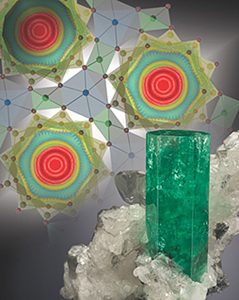
The interactions of water with the surrounding rock ore deposits create geothermal energy and mineral deposits. The properties of water and other fluids change when they are confined in very small pores. In analyzing the properties of water molecules confined inside an emerald at extremely low temperature (about 5 K or -451 Fahrenheit), scientists at Oak Ridge National Laboratory found that individual molecules undergo a transition, essentially existing simultaneously as six copies of itself, each of which is, in a sense, 1/6 “present.” The formula might be written “H12/6O” instead of “H2O.” This is a completely new kind of water molecule, created through the agency of quantum tunneling, whose shape has been altered to conform to the symmetry of the environment in which it is trapped.
The Impact
The revelation of this tunneling state of water will enable scientists to better describe the thermodynamic properties and behavior of water in highly confined environments. Knowledge of the temperature dependence of the scattering signal serves as an important constraint on theoretical calculations of the H2O-H12/6O transition at very low temperature. Knowledge of the details of this transformation can then be used to make more accurate predictions of water diffusion and transport in higher temperature systems such as in the channels of cell membranes, in carbon nanotubes, and along grain boundaries and at mineral interfaces in a variety of geological environments.
Summary
The interactions of water with the surrounding rock matrix are responsible for geothermal energy, the formation of many ore deposits, and a number of other important geological processes. In many such systems, water may be present as no more than an ultrathin film along the boundaries between the mineral grains making up the rock.
Highly confined water is also present inside nanometer-sized channels present in the crystalline structures of some types of minerals and gems, where the atomic environment is much more regular and easier to characterize than in complex grain boundaries. New research by scientists at the Oak Ridge National Laboratory (ORNL) and their colleagues describes a new kind of water molecule, created by quantum tunneling, confined in hexagonal channels — 5 angstroms across — of the mineral beryl.
The discovery, made possible with experiments at ORNL’s Spallation Neutron Source and the Rutherford Appleton Laboratory in the United Kingdom, demonstrates that at low temperatures, water in these channels is “delocalized” over six symmetrically equivalent positions in the channel and assumes an unusual double-top-like shape (see the figure). This research not only provides the first evidence of a new quantum tunneling state of the water molecule, it also suggests that the vibrational spectra of surrounding minerals can reduce the activation energy for water transport on grain boundaries in geologic environments.
Compared to the non-tunneling molecule, the center of mass and the dipole moment of the delocalized water molecule are modified, thus modifying the interactions of the molecule with its surroundings and impacting our understanding of water and energy transport and reactivity. Neutron scattering and computational modeling revealed unique and unexpected behavior of water molecules under extreme confinement that is unmatched by any known gas, liquid, or solid states.
Reference:
A.I. Kolesnikov, G.F. Reiter, N. Choudhury, T.R. Prisk, E. Mamontov, A. Podlesnyak, G. Ehlers, A.G. Seel, D.J. Wesolowski, and L.M. Anovitz, “Quantum tunneling of water in beryl: A new state of the water moleculeExternal link.” Physical Review Letters 116, 167802 (2016). DOI: 10.1103/PhysRevLett.116.167802
Note: The above post is reprinted from materials provided by Department of Energy, Office of Science.










